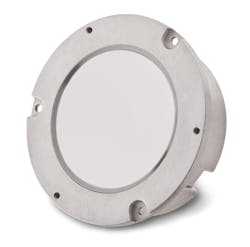Cree delivers modular LED light engine with 30% boost in performance (UPDATED)
The LMH2+ is the industry's highest performance modular SSL engine, according to Cree, and can enable luminaires to exceed 100 lm/W in system efficacy.
Cree has announced the next-generation LMH2+ modular LED light engine that luminaire makers can easily design in to products such as downlights, surface-mount ceiling fixtures, pendants, track heads, and other applications. The module delivers as much as 125 lm/W in efficacy at the system level, and Cree said luminaire system designs can hit levels in excess of 100 lm/W.
The LMH2 LED module family was first announced in late 2011 at lower lumen levels than what you will find today, but with 90-CRI capabilities from the start. Over the past few years, Cree has increased the performance, adding new family members and also adding features such as dim-to-warm functionality or what Cree calls Sunset Dimming.
The newest modular LED light engine delivers a 30% increase in performance for solid-state lighting (SSL) product designs, according to Cree. The company will offer the light engine over the range of 1250–3000 lm at a choice of CCT over the 2700K–4000K range. Cree will offer 90-CRI color performance across the product line.
Cree has eschewed support for industry-standard Zhaga form factors for its SSL modules. The company has said Zhaga adds cost and reduces flexibility in modular configurations.
With the module family, Cree has repeatedly stressed that the goal is ease of development for lighting manufacturers with the modular LED light engine serving as a development alternative to discrete and chip-on-board (COB) LEDs. The new product brings higher performance to the table. "Cree’s dedication to LED innovation is evident in the LMH2+," said Wesley Johnson, sales director, Hi-Lite Mfg. "This product is just what we are looking for to satisfy the higher efficacy requirements of our customers."
The new modular LED light engine can be used as a drop-in replacement for lighting products designed around the LMH2 family. Or the higher-performance module can allow manufacturers to shrink the form factor of luminaires designed with discrete sources.
It does appear that Cree may have changed course in how the new module is designed. The announcement said the module utilizes "elements of Cree’s innovative SC5 technology platform." SC5 is the technology behind the company's latest discrete LEDs. The use of the word "element" in the description is consistent with the way the Cree has described its newest COB LEDs, so the newest module may be based on such LEDs.
UPDATE: We speculated earlier that Cree may have used a COB LED in the latest LMH2+ SSL module design. Cree, however, has confirmed that the module actually uses discrete LEDs just as were used in the earlier module. The design uses a combination of what Cree calls blue-shifted-yellow (BSY) LEDs combined with red LEDs to deliver high CRI at warm CCTs while also maintaining high efficacy — one of the approaches that the company has used in its TrueWhite lighting products that deliver high CRI.
While Cree has long offered COB LEDs, most of its lighting products have used discrete packaged LEDs. That trend changed recently when the company announced a COB-based outdoor luminaire targeted at rural applications. The trend toward COBs has accelerated especially as optics technology for the larger sources have improved.

Maury Wright | Editor in Chief
Maury Wright is an electronics engineer turned technology journalist, who has focused specifically on the LED & Lighting industry for the past decade. Wright first wrote for LEDs Magazine as a contractor in 2010, and took over as Editor-in-Chief in 2012. He has broad experience in technology areas ranging from microprocessors to digital media to wireless networks that he gained over 30 years in the trade press. Wright has experience running global editorial operations, such as during his tenure as worldwide editorial director of EDN Magazine, and has been instrumental in launching publication websites going back to the earliest days of the Internet. Wright has won numerous industry awards, including multiple ASBPE national awards for B2B journalism excellence, and has received finalist recognition for LEDs Magazine in the FOLIO Eddie Awards. He received a BS in electrical engineering from Auburn University.






